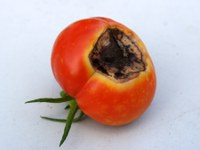Dakota Gardener: Preventing Rotten Tomatoes in a Drought
(Click an image below to view a high-resolution image that can be downloaded)
By Tom Kalb, Horticulturist
NDSU Extension
One of the greatest joys in summer is to harvest your first ripe tomato - unless the tomato is rotten.
Blossom end rot is the No. 1 threat to tomato plants in our gardens today. Our drought has made matters much worse this year.
Blossom end rot is most often associated with a lack of calcium in the fruits. Without enough calcium in their cell walls, the tomato fruits collapse at their bottoms.
Blossom end rot also is associated with drought, high temperatures and low humidities. All of these factors are occurring throughout North Dakota.
What’s the answer? We need to get more calcium to the fruits.
Some gardeners try to prevent this rot by adding calcium to the soil. They sprinkle eggshells and Tums near the plants. This approach isn’t bad but does little good because most soils in North Dakota have an abundance of calcium already in them.
Other gardeners add Epsom salts to the soil, but the magnesium in Epsom salts may worsen the situation.
The best strategy to reduce blossom end rot is to irrigate properly.
The uptake of calcium in the soil by tomato roots depends on the uptake of water. Irrigate regularly. Avoid extremes of waterlogged and droughty soil. Mulch to maintain consistent levels of moisture in the soil.
Cultivate shallowly. Don’t damage the roots of your tomato vines. We need these roots to absorb the calcium in the soil solution.
Your fertilization practices can make a difference. Do not overfertilize.
Tomato leaves compete with tomato fruits for calcium in the vine. Overfertilization will lead to vines full of leaves that will take calcium from the vine before the fruits can get it.
As a general rule, do not sidedress tomato vines with fertilizer until their first fruits are set.
Avoid fertilizers containing ammonium nitrate, a very common source of nitrogen. Ammonium ions compete with calcium ions for the limited areas on roots where nutrients are absorbed. Calcium nitrate is a better choice.
Calcium sprays are available that may prevent blossom end rot, but their effectiveness is inconsistent. Follow the instructions on the label.
You can prepare your own spray if you want to give it a try. Mix 4 tablespoons of calcium nitrate per gallon of water. Spray fruits, not leaves, two to three times a week. The key time is when tomatoes are dime sized or smaller.
Now is a good time to inspect your tomatoes to see if they are rotten. The first cluster of fruits is most often damaged. Remove any rotten fruits.
Subsequent clusters of fruits are much less susceptible to blossom end rot. As summer progresses, the vine’s network of roots expands, allowing it to absorb more calcium into the plant. The leaves and fruits on the vine are in better balance later in summer, too.
Focus your attention on irrigating your garden when needed and don’t overfertilize. Soon you will be enjoying lots of tasty tomatoes this summer.
For more information about gardening, contact your local NDSU Extension agent. Find the Extension office for your county at https://www.ag.ndsu.edu/extension/directory/counties.
NDSU Agriculture Communication
Source: Tom Kalb, 701-328-9722, tom.kalb@ndsu.edu
Editor: Ellen Crawford, 701-231-5391, ellen.crawford@ndsu.edu




